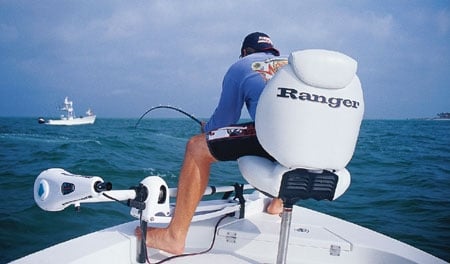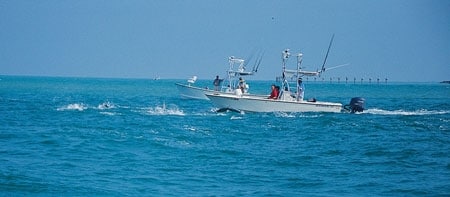
Tarpon fishing in Boca Grande is truly a special experience, and my first trip there was a big success. Seconds after my jig reached bottom, I felt a distinct tap. I cranked the reel handle steadily once the line came tight. But as I drew the last of the slack onto the spool, the line snapped taut and reversed direction. While psyched to be tethered to my first Boca Grande tarpon, I wondered how I would ever land it, stuck in the middle of a traffic jam of Miami-at-rush-hour proportions.
Scampering into the fighting chair bolted to the bow deck of the bay boat, I tried to stay focused and keep steady pressure on the fish even as boats power-drifted all around us.
My tutor, Captain Ray Van Horn, offered encouragement as he skillfully maneuvered his boat through the crowded waterway.
After several long minutes I managed to pump the tarpon to the surface. The leader was just a few feet shy of reaching the rod tip when the 90-pounder surged again and pulled the hook. I was disappointed, but soon realized it didn’t matter. There were more where that one came from-literally, thousands more.
A quick glance at a fishfinder showed tarpon stacked like cordwood across the bottom of the pass.
Fishing for Tarpon in Boca Grande: King of the Road
Tarpon appear in droves every spring in Boca Grande Pass, the entry to Florida’s Charlotte Harbor between Gasparilla Island and Cayo Costa. Enough fish show up consistently from year to year that it is considered the largest gathering of tarpon in the world. And anglers gripped by tarpon fever endure bumper car-like conditions and hungry sharks for shots at huge silver kings.
The season in the pass gets going in earnest by early April, as the tarpon migrate north from the Keys and open Gulf, lingering here to spawn and feed on the crabs and baitfish that flush continuously through the narrow channel. That bite continues on into the first of July, when the water temperatures soar with the summer heat. The tarpon then scatter throughout Charlotte Harbor and elsewhere. Many migrate north; some head as far west as Texas.
This annual rendezvous draws anglers from around the globe. For your initial Boca Grande Tarpon excursion, Van Horn suggests hiring a guide. “That would be money well spent,” he says. “You’ll receive good instruction from the captain and learn the nuances of a potentially dangerous situation.”
A little local knowledge can’t hurt.
Van Horn has been guiding clients to big ‘poons for 14 years and is one of a new breed of guides who annually targets the pass. An average half-day trip will see seven to eight fish in six hours. During the season when tarpon fishing in Boca Grance is at its peak, jig guides typically run two trips daily.
Van Horn is one of the several dozen guides who fish lures exclusively during daylight hours. “To me, the magnificence of a tarpon is when he’s six feet in the air, the sun is gleaming off him, and he looks like a sack full of brand-new silver dollars,” he says. “You miss all that excitement at night.”
The self-proclaimed “traditional” guides, who have fished Boca Grande for decades, troll live squirrelfish, crabs and shrimp at night. Using 80-pound Dacron line and wire leaders, these baits are pulled well off the bottom to entice tarpon that rise in the water column once the light dims. After the sun comes up, however, the fish resume their daylight position along the pass floor. Each morning the shift changes as the live-bait and jig boats swap places.
The daytime jig guides use custom hookless jigheads weighing up to six ounces that are attached to 7/0 Daiichi Ultra Wide circle hooks with plastic zip ties. The ties must have a breaking strength equal to or exceeding that of the fishing line. Scented plastic minnows are impaled on the jig. These heavy artificial baits reach the pass floor quickly, but once an angler gets used to the feel of the bottom contour and current, the weight can be reduced by as much as two ounces. The jighead remains in place, and the circle hooks have improved hook-up ratios.
Van Horn uses Abu Garcia M¿rrum 7000 casting outfits spooled with 50-pound fluorocarbon main line. He doubles the last couple of feet by tying a Bimini twist and then adds a section of 100-pound fluorocarbon leader via a bristol or no-name knot. A palomar knot connects the hook.
For his lure bodies, Van Horn uses three- and four-inch Berkley Powerbait Salt Water Mullet exclusively. Dark colors like red or brown are his go-to patterns in low light, but once the sun rises overhead, he’ll switch to chartreuse and other light colors.
“I’ve found the scented baits work better,” Van Horn says. “It’s all about presentation and keeping them in the strike zone.”
And Van Horn and his cohorts battle more than just tarpon. Competition between jig and bait fishermen has resulted in shouting matches and confrontations, and the growing controversy prompted the Florida Fish & Wildlife Conservation Commission (FWC) to take action. Starting a year ago in April, the FWC established rules that prohibit the use of breakaway gear. Prior to this, jig fishermen temporarily attached the heavy jigheads with light line, copper wire or rubber bands that broke away once a fish was hooked. Breakaway jigs had better landing rates since the fish weren’t able to sling the jig and throw the hook, but the discarded leadheads and other debris were a bone of contention for the live-bait fleet. The new regulations are enforced throughout April, May and June each year. FWC officers patrol the area to ensure gear compliance and safe boating.
Drift and Drive

To keep the jigs within that critical zone, Van Horn circles the fleet and idles uptide, past the schooled fish, before he begins a controlled drift under power, typically pointing the bow into the wind. Jig boats always drift stern-to to keep the lines as vertical as possible, whereas live-bait boats drift bow-to to set the hook with the boat after a strike.
On weekdays in season, as many as 60 jig boats might be fishing the narrow pass. On weekends, that total may increase to 200 boats, so skillful boat handling and an understanding of protocol are paramount.
“Safety is always the first priority and hooked fish are second,” Van Horn explains. “You should always make way for someone fighting a fish by clearing your lines and getting out of the way, because you want that same courtesy extended to you when you’re hooked up. The pass gets extremely congested during the season and cool heads have to prevail. There’s a strong camaraderie among the jig guides, and we all work well together.”
Mid-sized bay boats with single outboard power are a popular choice among the professional guide fleet. Van Horn runs a 2200 Bay Ranger with a 225-horsepower Evinrude
E-TEC engine. Its maneuverability helped avoid numerous close encounters with other boats on the day we fished together. He was also able to change directions quickly to keep maximum pressure on the fish.
“We really encourage quick fights,” Van Horn says. “As soon as the fish slows just a little, pour on the pressure. You always want to change rod angles, too. The more hurt you can put on that fish, the more aggravated it gets. That makes it burn more energy on jumps, which shortens the fight. If you sit in the chair and cruise, that fish is gonna cruise also. And that’s not good for either the angler or the tarpon.”
Most of the jig boats are equipped with bow fighting chairs with rod gimbals, although standup fishing is not uncommon. When my buddy Glyn Austin hooked a tarpon that weighed well over 100 pounds, he exerted maximum pressure from the chair, and the fight was over in less than 20 minutes. But after a quick revival and release, we watched in frustration as a large bull shark attacked and devoured Austin’s prize. Shark encounters are a routine occurrence in Boca Grande Pass.
According to Van Horn, the most common sharks are bulls up to nine feet and hammerheads that often reach 14 feet long. Tiger sharks will sometimes make appearances as well. To minimize the risk of losing a tarpon to sharks, guides encourage anglers to keep the fight under 15 minutes. Longer battles cause more lactic acid to build up within the tarpon’s body, prolonging fatigue and decreasing its chances of outrunning predators.
Airborne tarpon are another hazard of Boca Grande Pass. With the boats in such close proximity and the likelihood that several fights may be underway simultaneously, the odds of a tarpon jumping into a boat uninvited are better here than anywhere else. In his 14 years as a guide, Van Horn has had four come aboard, including a 200-pounder early last season.
“It’s all about being in the wrong place at the wrong time,” he says. “You certainly don’t want anyone to get hurt, which is why you need to discuss the drill beforehand: Be cool, get away from the fish and let it settle down before you put a wet towel over its head and slide it back overboard.” The crowds of springtime anglers disperse as the tarpon move on.
Boca Grande lights up again in the last part of October as the fish return on their trek south following schools of threadfin herring. The fall run is much shorter-it might last only a week. But there are usually only a few boats fishing, so the action can be red hot. But the main event is still each spring, when thousands of these challenging gamefish arrive, as if on schedule, at the tarpon crossroads of the world.
Tarpon Fishing in Boca Grande Equals Crowds
Big Boca not your speed? Try these other tarpon fishing locations.
If you want to avoid congestion at the pass, there are two prime alternatives for tarpon in the Charlotte Harbor area: the Gulf beaches and Pine Island Sound.
Beach patrollers motor along the sugar-sand beaches, scouting for pods of fish. These anglers maneuver into casting position by idling or using a trolling motor to get ahead of the anticipated track and use live crabs, swimming plugs and flies.
For Keys-style action, the east and west banks of Pine Island Sound, inside the barrier islands, offer consistent shots at tarpon in four to six feet of water. Tarpon ranging from 40 to 130 pounds can be found rolling among sandy potholes scattered throughout the turtle grass in the early morning hours. The tarpon feed on crabs and baitfish, but as the sun climbs overhead, the fish “lay up” or suspend motionless just below the surface.
“You have to force-feed these fish,” says 20-year Charlotte Harbor veteran Bryan Watts. “The baits have to be on their nose.”
– D.L.









